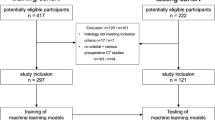Abstract
Intramedullary + extramedullary hemangioblastomas with largely extramedullary growth are rare and often incorrectly assigned as intradural-extramedullary tumors preoperatively. Preoperative evaluation of the precise tumor location is important for total resection of tumor and improving the surgical outcome. The aim of this study was to provide the first identification of the key differences among of preoperative MR images of hemangioblastomas in different locations and to correlate these with pathological findings. The subjects were 26 patients with surgery for spinal hemangioblastoma in our department, including 6 with an intramedullary tumor who were complicated with von Hippel Lindau disease. Intramedullary, intramedullary + extramedullary, and intradural-extramedullary tumors were present in 22, 3 and 1 cases, respectively. Sagittal MR images showed that intramedullary and intramedullary + extramedullary tumors gave intramedullary T2 high intensity areas (HIAs) spreading toward the craniocaudal sides of the tumor, whereas such findings were absent for the intradural-extramedullary tumor. All the tumors showed strong contrast on axial images, with focal enhancement of hemangioblastomas limited to the intramedullary region (focal type); smooth boundary lines between the spinal cord and the extramedullary tumor (smooth type); and a snowman sign for intramedullary + extramedullary tumors, which provided a key characteristic for differentiating intramedullary + extramedullary tumors from those limited to the extramedullary region. In pathological findings, the Ki67 activity was less than 1% for intramedullary and intradural-extramedullary tumors, but 18–25% in all cases with an intramedullary + extramedullary tumor. In conclusion, on preoperative MRI, a change in the intramedullary HIAs spreading the craniocaudal sides of the tumor on sagittal T2 weighted image (T2WI) and a snowman sign on contrast axial T1WI may be important for differentiation among spinal hemangioblastomas in different locations. Pathologically, we found that intramedullary + extramedullary hemangioblastoma has high cell proliferative activity, which may suggest that enlargement of this tumor occurs faster than that of intramedullary hemangioblastoma.







Similar content being viewed by others
References
Browne TR, Adams RD, Roberson GH (1976) Hemangioblastoma of the spinal cord. Review and report of five cases. Arch Neurol 33:435–441
Yasargil MG, Antic J, Laciga R, de Preux J, Fideler RW, Boone SC (1976) The microsurgical removal of intramedullary spinal hemangioblastomas. Report of twelve cases and a review of the literature. Surg Neurol 1976:141–148
Parsa AT, Lee J, Parney IF, Weinstein P, McCormick PC, Ames C (2004) Spinal cord and intradural-extraparenchymal spinal tumors: current best care practices and strategies. J Neurooncol 69:291–318
Bostrom A, Hans FJ, Reinacher PC, Krings T, Burgel U, Gilsbach JM, Reinges MH (2008) Intramedullary hemangioblastomas: timing of surgery, microsurgical technique and follow-up in 23 patients. Eur Spine J 17:882–886. doi:10.1007/s00586-008-0658-1
Brisman JL, Borges LF, Ogilvy CS (2000) Extramedullary hemangioblastoma of the conus medullaris. Acta Neurochir (Wien) 142:1059–1062
Shin DA, Kim SH, Kim KN, Shin HC, Yoon DH (2008) Surgical management of spinal cord haemangioblastoma. Acta Neurochir (Wien) 150:215–220; discussion 220. doi:10.1007/s00701-008-1396-6
Wisoff HS, Suzuki Y, Llena JF, Fine DI (1978) Extramedullary hemangioblastoma of the spinal cord. Case report. J Neurosurg 48:461–464. doi:10.3171/jns.1978.48.3.0461
Taniguchi S, Ogikubo O, Nakamura T, Yamagishi I, Hayakawa K, Otsuka T, Katoh T (2009) A rare case of extramedullary-intradural hemangioblastoma in the thoracic spine. Spine (Phila Pa 1976) 34:E969–E972. doi:10.1097/BRS.0b013e3181b8e4f4
Bloomer CW, Ackerman A, Bhatia RG (2006) Imaging for spine tumors and new applications. Top Magn Reson Imaging 17:69–87. doi:10.1097/RMR.0b013e31802bb38f
Van Velthoven V, Reinacher PC, Klisch J, Neumann HP, Glasker S (2003) Treatment of intramedullary hemangioblastomas, with special attention to von Hippel-Lindau disease. Neurosurgery 53:1306–1313; discussion 1313–1304
Nemoto Y, Inoue Y, Tashiro T, Mochizuki K, Oda J, Kogame S, Katsuyama J, Hakuba A, Onoyama Y (1992) Intramedullary spinal cord tumors: significance of associated hemorrhage at MR imaging. Radiology 182:793–796
Chu BC, Terae S, Hida K, Furukawa M, Abe S, Miyasaka K (2001) MR findings in spinal hemangioblastoma: correlation with symptoms and with angiographic and surgical findings. AJNR Am J Neuroradiol 22:206–217
Toyoda H, Seki M, Nakamura H, Inoue Y, Yamano Y, Takaoka K (2004) Intradural extramedullary hemangioblastoma differentiated by MR images in the cervical spine: a case report and review of the literature. J Spinal Disord Tech 17:343–347. 00024720-200408000-00018 [pii]
Barbosa-Silva E, Carvalho GT, Frota Mde O, Sousa AA, Souza CB (2009) Intradural extramedullary hemangioblastoma. Arq Neuropsiquiatr 67:530–533. S0004-282X2009000300033 [pii]
Lonser RR, Oldfield EH (2005) Microsurgical resection of spinal cord hemangioblastomas. Neurosurgery 57:372–376; discussion 372–376. 00006123-200510004-00021 [pii]
Lonser RR, Weil RJ, Wanebo JE, DeVroom HL, Oldfield EH (2003) Surgical management of spinal cord hemangioblastomas in patients with von Hippel-Lindau disease. J Neurosurg 98:106–116. doi:10.3171/jns.2003.98.1.0106
Shively SB, Beltaifa S, Gehrs B, Duong H, Smith J, Edwards NA, Lonser R, Raffeld M, Vortmeyer AO (2008) Protracted haemangioblastic proliferation and differentiation in von Hippel-Lindau disease. J Pathol 216:514–520. doi:10.1002/path.2435
Acknowledgments
The authors thank Ms. Saho Horiuchi for her assistance throughout this study.
Conflict of interest
None.
Author information
Authors and Affiliations
Corresponding author
Additional information
This paper is designed and submitted acting on guideline of IRB of Nagoya University Graduate School of Medicine and all patients have signed consent forms for this study.
Rights and permissions
About this article
Cite this article
Imagama, S., Ito, Z., Wakao, N. et al. Differentiation of localization of spinal hemangioblastomas based on imaging and pathological findings. Eur Spine J 20, 1377–1384 (2011). https://doi.org/10.1007/s00586-011-1814-6
Received:
Accepted:
Published:
Issue Date:
DOI: https://doi.org/10.1007/s00586-011-1814-6




